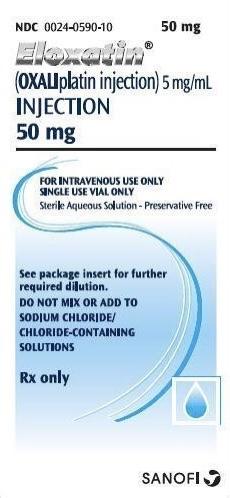Eloxatin Disease Interactions
There are 7 disease interactions with Eloxatin (oxaliplatin).
- Arrhythmias
- Pulmonary toxicity
- Neurologic toxicity
- Neutropenia
- Renal impairment
- Rhabdomyolysis
- Thrombocytopenia
Oxaliplatin (applies to Eloxatin) arrhythmias
Major Potential Hazard, High plausibility. Applicable conditions: Electrolyte Abnormalities
The use of oxaliplatin has been associated with QT prolongation, and ventricular arrhythmias including fatal Torsade de Pointes. Therapy with oxaliplatin should be administered cautiously in patients with congestive heart failure, bradyarrhythmias, and electrolyte abnormalities. Correct hypokalemia or hypomagnesemia prior to initiating oxaliplatin and monitor these electrolytes periodically during therapy. Avoid oxaliplatin in patients with congenital long QT syndrome.
References (1)
- (2002) "Product Information. Eloxatin (oxaliplatin)." Sanofi Winthrop Pharmaceuticals
Oxaliplatin (applies to Eloxatin) pulmonary toxicity
Major Potential Hazard, Moderate plausibility. Applicable conditions: Pulmonary Impairment
Oxaliplatin has been associated with pulmonary fibrosis (<1% of study patients), which may be fatal. Caution should be exercised when administering oxaliplatin in patients with compromised pulmonary function. Patients should be instructed to immediately report symptoms of unexplained respiratory symptoms such as non-productive cough, dyspnea, crackles, or radiological pulmonary infiltrates. Close clinical monitoring of pulmonary function is recommended and oxaliplatin should be discontinued until further pulmonary investigation excludes interstitial lung disease or pulmonary fibrosis.
References (1)
- (2002) "Product Information. Eloxatin (oxaliplatin)." Sanofi Winthrop Pharmaceuticals
Oxaliplatin (applies to Eloxatin) neurologic toxicity
Moderate Potential Hazard, Moderate plausibility. Applicable conditions: Neurologic Disorder, Peripheral Neuropathy
Oxaliplatin for injection is associated with two types of neuropathy. An acute, reversible, primarily peripheral, sensory neuropathy that is of early onset, occurring within hours or one to two days of dosing, that resolves within 14 days, and that frequently recurs with further dosing and a persistent (>14 days), primarily peripheral, sensory neuropathy that is usually characterized by paresthesias, dysesthesias, hypoesthesias, but may also include deficits in proprioception that can interfere with daily activities (e.g., writing, buttoning, swallowing, and difficulty walking from impaired proprioception). Ice (mucositis prophylaxis) should be avoided during the infusion of oxaliplatin for Injection because cold temperature can exacerbate acute neurological symptoms. Therapy with oxaliplatin should be administered cautiously in patients with or predisposed to neurologic dysfunction.
References (1)
- (2002) "Product Information. Eloxatin (oxaliplatin)." Sanofi Winthrop Pharmaceuticals
Oxaliplatin (applies to Eloxatin) neutropenia
Moderate Potential Hazard, Moderate plausibility. Applicable conditions: Infection - Bacterial/Fungal/Protozoal/Viral
The use of oxaliplatin for injection and 5-fluorouracil/leucovorin has been associated with sepsis, neutropenic sepsis and septic shock with fatal outcomes. Therapy with oxaliplatin should be administered cautiously in patients predisposed to neutropenia. Patients should be warned to report any febrile illness.
References (1)
- (2002) "Product Information. Eloxatin (oxaliplatin)." Sanofi Winthrop Pharmaceuticals
Oxaliplatin (applies to Eloxatin) renal impairment
Moderate Potential Hazard, Moderate plausibility. Applicable conditions: Renal Dysfunction
The major route of platinum elimination is renal excretion. The exposure (AUC) of unbound platinum in plasma ultrafiltrate tends to increase in renally impaired patients. The starting dose of oxaliplatin should be reduced in patients with severe renal impairment (creatinine clearance < 30 mL/min). Caution and close monitoring should be exercised when oxaliplatin is administered to patients with renal impairment.
References (1)
- (2002) "Product Information. Eloxatin (oxaliplatin)." Sanofi Winthrop Pharmaceuticals
Oxaliplatin (applies to Eloxatin) rhabdomyolysis
Moderate Potential Hazard, Moderate plausibility. Applicable conditions: Myopathy, Myoneural Disorder
Rhabdomyolysis, including fatal cases, has been reported during the administration of oxaliplatin. Therapy with oxaliplatin should be administered cautiously in patients with or predisposed to myopathy. Clinical monitoring is recommended during therapy with oxaliplatin and discontinuation of therapy if any signs or symptoms of rhabdomyolysis occur.
References (1)
- (2002) "Product Information. Eloxatin (oxaliplatin)." Sanofi Winthrop Pharmaceuticals
Oxaliplatin (applies to Eloxatin) thrombocytopenia
Moderate Potential Hazard, Moderate plausibility. Applicable conditions: Bone Marrow Depression/Low Blood Counts, Bleeding
Thrombocytopenia was frequently reported with the combination of oxaliplatin and infusional 5-FU/LV. Therapy with oxaliplatin should be administered cautiously in patients whose bone marrow reserve may be severely depressed by prior chemotherapy or irradiation, whose marrow function is recovering from previous cytotoxic therapy, or in patients with compromised renal function. Patients should be instructed to immediately report any signs or symptoms suggesting bleeding such as petechia, purpura, epistaxis, hemoptysis, hematuria, and melena. Therapy with oxaliplatin should be administered cautiously in patients with compromised bone marrow reserve. Close clinical monitoring of hematopoietic function is recommended.
References (1)
- (2002) "Product Information. Eloxatin (oxaliplatin)." Sanofi Winthrop Pharmaceuticals
Switch to consumer interaction data
Eloxatin drug interactions
There are 639 drug interactions with Eloxatin (oxaliplatin).
More about Eloxatin (oxaliplatin)
- Eloxatin consumer information
- Check interactions
- Compare alternatives
- Drug images
- Side effects
- Dosage information
- During pregnancy
- FDA approval history
- Drug class: alkylating agents
- Breastfeeding
Related treatment guides
Drug Interaction Classification
| Highly clinically significant. Avoid combinations; the risk of the interaction outweighs the benefit. | |
| Moderately clinically significant. Usually avoid combinations; use it only under special circumstances. | |
| Minimally clinically significant. Minimize risk; assess risk and consider an alternative drug, take steps to circumvent the interaction risk and/or institute a monitoring plan. | |
| No interaction information available. |
See also:
Further information
Always consult your healthcare provider to ensure the information displayed on this page applies to your personal circumstances.


